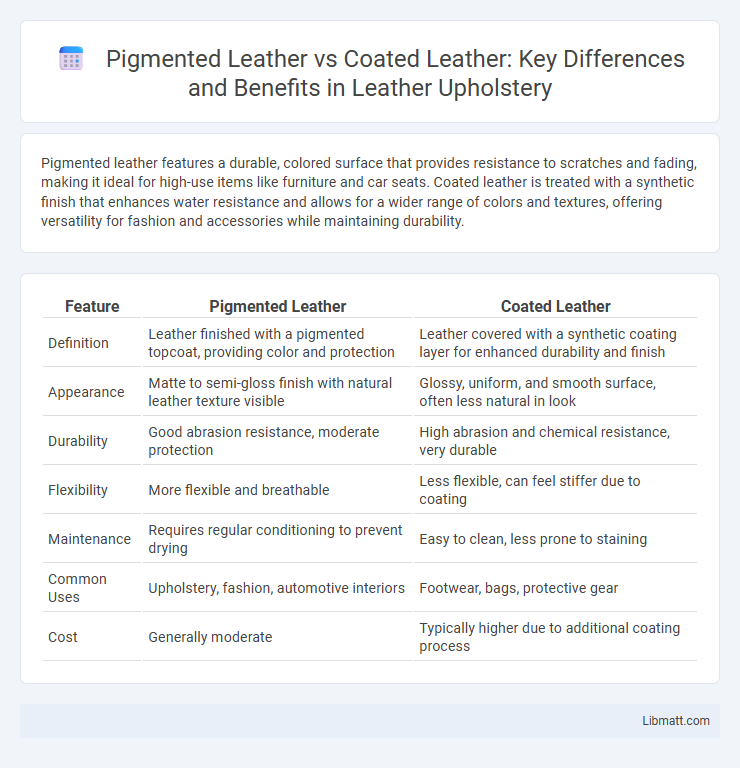Pigmented leather features a durable, colored surface that provides resistance to scratches and fading, making it ideal for high-use items like furniture and car seats. Coated leather is treated with a synthetic finish that enhances water resistance and allows for a wider range of colors and textures, offering versatility for fashion and accessories while maintaining durability.
Table of Comparison
| Feature | Pigmented Leather | Coated Leather |
|---|---|---|
| Definition | Leather finished with a pigmented topcoat, providing color and protection | Leather covered with a synthetic coating layer for enhanced durability and finish |
| Appearance | Matte to semi-gloss finish with natural leather texture visible | Glossy, uniform, and smooth surface, often less natural in look |
| Durability | Good abrasion resistance, moderate protection | High abrasion and chemical resistance, very durable |
| Flexibility | More flexible and breathable | Less flexible, can feel stiffer due to coating |
| Maintenance | Requires regular conditioning to prevent drying | Easy to clean, less prone to staining |
| Common Uses | Upholstery, fashion, automotive interiors | Footwear, bags, protective gear |
| Cost | Generally moderate | Typically higher due to additional coating process |
Introduction to Pigmented and Coated Leather
Pigmented leather features a strong, opaque layer of paint that covers the leather's surface, enhancing durability and resistance to stains and scratches. Coated leather combines a base leather with a polymer finish, offering a smooth, uniform appearance and added protection against wear and moisture. Understanding these differences helps you choose the ideal leather type for your furniture or accessories based on appearance and longevity needs.
What Is Pigmented Leather?
Pigmented leather features a surface coating of pigments that enhances durability and uniform color, making it resistant to stains and fading. This type of leather retains the natural texture beneath the pigmentation, providing a smooth and consistent finish ideal for furniture and automotive upholstery. Compared to coated leather, pigmented leather emphasizes protection through a pigmented layer rather than a synthetic film, balancing aesthetics with longevity.
What Is Coated Leather?
Coated leather features a surface layer made from polymer materials like polyurethane or acrylic, which is applied to enhance durability and water resistance. Unlike pigmented leather that uses pigment dyes to color the hide naturally, coated leather has a protective finish that shields against scratches and stains. Your choice of coated leather ensures easier maintenance and a longer-lasting appearance suitable for high-use items such as furniture and automotive interiors.
Key Differences: Pigmented vs Coated Leather
Pigmented leather features a durable, opaque surface layer that protects natural grain underneath, offering excellent resistance to scratches and fading. Coated leather is treated with a synthetic polymer finish, providing a glossy or matte appearance but often sacrificing breathability and the natural feel of the hide. The primary distinction lies in durability and texture retention, with pigmented leather maintaining a more authentic look over time compared to the often artificial finish of coated leather.
Durability Comparison
Pigmented leather features a solid color layer that provides superior durability and resistance to scratches and stains compared to coated leather, which has a surface finish applied after dyeing. Coated leather may be more prone to cracking and peeling over time due to its synthetic layer, making it less durable in high-wear applications. The robust pigment layer in pigmented leather also offers better protection against fading from UV exposure, enhancing its longevity for furniture and automotive use.
Appearance and Texture
Pigmented leather features a solid, uniform color due to its thick surface coating, resulting in a smooth, consistent texture with high durability and resistance to stains and fading. Coated leather, often finished with a thinner, flexible polymer layer, presents a more natural grain visibility and a softer, more supple feel that enhances comfort and luxury appeal. The choice between pigmented and coated leather depends on the desired balance between a polished, long-lasting finish and the tactile experience of genuine leather texture.
Maintenance and Care Requirements
Pigmented leather offers high durability and resists stains and UV damage, making its maintenance easier with regular dusting and occasional wiping using a damp cloth. Coated leather has a protective finish that can wear off over time, requiring gentle cleaning and conditioning to prevent cracking and maintain flexibility. You should avoid harsh chemicals on both types to preserve their appearance and longevity.
Common Applications and Uses
Pigmented leather, known for its durability and uniform finish, is commonly used in automotive interiors, furniture upholstery, and footwear, where consistent appearance and resistance to wear are essential. Coated leather, featuring a protective synthetic layer, finds frequent application in fashion accessories, handbags, and garments, offering enhanced water resistance and customizable surface effects. Both types cater to distinct market needs, balancing aesthetics and performance based on specific product requirements.
Pros and Cons: Pigmented vs Coated Leather
Pigmented leather offers excellent durability and resistance to scratches due to its thick protective paint layer, making it ideal for high-traffic applications, but it may compromise natural texture and breathability. Coated leather provides a softer feel and enhanced aesthetic appeal with a thinner, more flexible finish, although it is generally less resistant to wear and may peel over time. Choosing between pigmented and coated leather depends on the balance between durability and aesthetic preferences specific to the intended use.
Choosing the Right Leather for Your Needs
Pigmented leather features a uniform surface with a protective paint-like finish, offering durability and resistance to stains, ideal for high-traffic furniture or automotive interiors. Coated leather, on the other hand, has a clear polyurethane layer that enhances softness and offers better breathability, making it perfect for garments and luxury accessories where comfort is key. Understanding the differences in maintenance and wear can help you choose the right leather for your needs, balancing appearance, comfort, and longevity.
Pigmented leather vs coated leather Infographic

 libmatt.com
libmatt.com